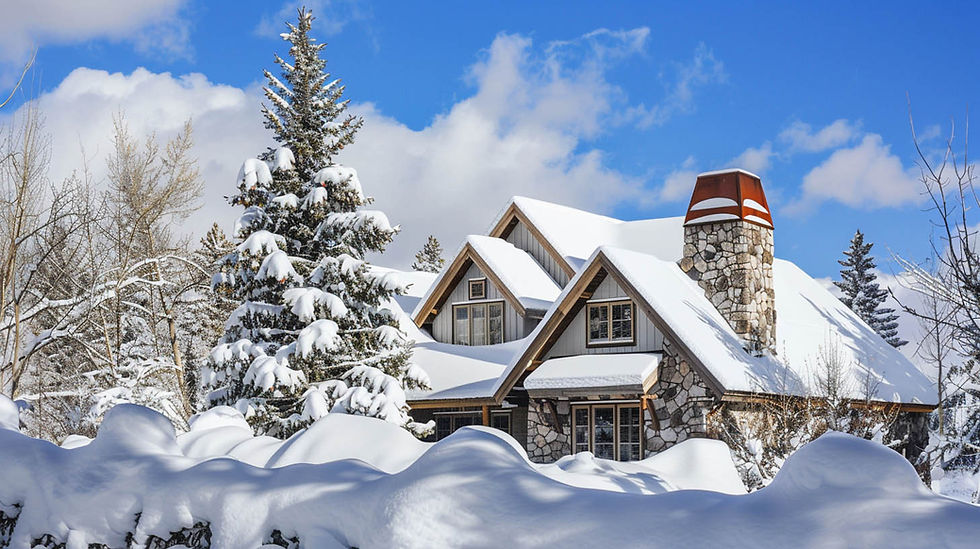Roof Snow Shedding Strategies: Design Tips to Prevent Snow Buildup
- Joseph Justice
- Sep 19
- 5 min read
Winter in Fort Wayne, IN, brings beautiful snowy landscapes, but it also presents a significant challenge for homeowners: accumulation on the roof. At Indiana Metal Roofing Systems, we understand that the weight of heavy snow can put immense stress on your home's structure, leading to costly damage. That's why effective roof snow shedding isn't just about convenience; it's about protecting your investment. Our company specializes in advanced roofing solutions designed to combat buildup and enhance the durability of your roof. This guide will explore proven roof design strategies and material choices that we offer, ensuring you have the best protection and peace of mind throughout the winter months.
Understanding the Challenges of Roof Snow Buildup in Fort Wayne, IN
In Fort Wayne, IN, winter conditions present unique challenges for homeowners, particularly related to accumulation on roofs. Heavy snowfall can create significant structural stress due to the weight of snow, leading to potential damage and the risk of ice dams. Additionally, local building codes dictate load requirements that must be met to ensure structural integrity. Understanding these factors is crucial for making informed design choices that enhance snow shedding while maintaining the aesthetic appeal of the roof structure.
Common Winter Weather Issues Affecting Residential Roofs
Heavy snowfall presents significant challenges for residential roofs, especially regarding snow load requirements and the structural integrity they must maintain. Accumulation of snow can lead to excessive weight, potentially causing structural damage or leading to dangerous slides. Additionally, winter conditions can result in the formation of ice dams, which trap water and contribute to problems like leaks. Homeowners should prioritize proper insulation and roof inspections, ensuring their roofs can withstand local climate variables and heavy snow loads throughout the winter months.

Risks of Snow Accumulation for Homeowners
Snow accumulation poses significant risks for homeowners, primarily due to the excessive weight added to the roof structure. This leads to structural stress, which can compromise the integrity of the building. Potential hazards include damage, the formation of ice dams, and even the collapse of weaker roofs under heavy snow loads. Maintaining proper drainage systems and conducting regular inspections can mitigate these dangers, ensuring safety during winter months and protecting against costly repairs associated with buildup.
Key Principles of Effective Roof Snow Shedding
Effective roof snow shedding relies on several essential principles that enhance structural integrity and prevent excessive accumulation. A steeper roof pitch facilitates faster slide, reducing the chance of heavy snow loads and the formation of ice dams. Incorporating proper drainage systems is crucial, ensuring that melted flows away without causing potential damage. Additionally, local building codes must be adhered to for safety. Each design choice, from shape to the right materials, plays a vital role in managing winter conditions and winter months efficiently.
The Science Behind Snow Shedding and Roof Design
Effective roof design is integral to managing snow shedding. The angle of a roof pitch greatly influences how accumulates and subsequently sheds. Steeper roof slopes encourage snow to slide off rather than collect, reducing the risk of structural stress from heavy loads. Structural integrity is preserved when roofs effectively utilize local climate considerations, including prevalent wind patterns. Innovative design choices, such as incorporating drainage systems and guards, further optimize the snow shedding process while maintaining aesthetic appeal.

How Roof Pitch Impacts Snow Accumulation and Shedding
Roof pitch significantly influences both accumulation and shedding on residential structures. Steeper roof slopes promote effective snow shedding, minimizing the risk of excessive weight that can lead to structural integrity issues. Conversely, flatter roofs tend to trap snow, creating potential hazards such as the formation of ice dams. Understanding the dynamics of local weather patterns and selecting the right pitch are crucial design choices for homeowners, ensuring effective management and safeguarding against winter-related structural damage.
Essential Roof Design Features for Management
Effective management hinges on incorporating essential roof design features. Optimal shapes, such as steep roof pitches and sloped designs, facilitate snow shedding, reducing the risk of ice buildup and structural stress. Overhangs play a crucial role in directing snow away from vulnerable areas, while strategically designed valleys enhance drainage systems to prevent accumulation. Roof inspections are vital to ensuring these design choices maintain structural integrity, especially in snowy climates where heavy snowfall can pose potential hazards for homeowners.
Optimal Roof Shapes and Styles for Shedding
Efficient snow shedding begins with selecting the right shape and style. Steep roof slopes naturally encourage snow to slide off, significantly reducing the risks of excessive weight and structural stress. Gable or hipped roofs are excellent choices as they facilitate effective drainage and diminish accumulation. Additionally, incorporating features like guards can enhance the design, preventing the sudden slide that might pose potential hazards. Ultimately, proper roofing solutions ensure durability and peace of mind during winter months.

Choosing the Right Roofing Material for Snowy Climates
Selecting appropriate roofing materials plays a crucial role in effective management. In snowy climates, metal roofing stands out as an excellent choice due to its superior shedding capabilities. Unlike traditional materials such as asphalt shingles, which may trap snow and increase the risk of ice dams, metal roofs provide a smoother surface that facilitates slides, minimizing excessive weight and structural stress. Additionally, considering local building codes ensures that chosen materials can withstand heavy snowfall without compromising structural integrity.
Advantages of Metal Roofing
Durability and resilience are major advantages of metal roofing, especially for snowy climates. The smooth surface facilitates efficient shedding, reducing the risk of heavy accumulation and potential structural damage. Furthermore, metal often feature steeper roof pitches, aiding in the swift removal of snow and preventing ice dam formation. Their excellent thermal properties enhance insulation, minimizing heat loss and promoting melt. This combination of factors ensures peace of mind, satisfying both functional needs and aesthetic appeal.
Get in Touch
Effective roof shedding strategies are essential for maintaining the structural integrity of homes, particularly in snowy climates like Fort Wayne, IN. With our A+ BBB rating and 5 Star Google rating, homeowners can trust our expertise in understanding the importance of proper design choices, including pitch and suitable materials, to significantly reduce the risks associated with accumulation and the formation of ice dams. Prioritizing optimal drainage systems and routine inspections, backed by our outstanding reputation, ensures peace of mind during winter months, ultimately safeguarding against potential damage from heavy loads and providing a safe living environment.
Frequently Asked Questions
How to keep from building up on your roof?
To prevent snow buildup on your roof, consider incorporating steep pitches, using metal roofing materials, and installing adequate overhangs. Regular maintenance and strategic design features can also enhance snow shedding efficiency, protecting your home from potential damage during winter months.
What is the best roof design for heavy snow load?
The best roof design for a heavy snow load is a simple, steep-sloped style, such as a gable roof. This design uses gravity to shed naturally, which reduces the load on the roof’s structural integrity. Avoid complex designs with lots of recesses.
Read our blog: Protecting Roof Edges & Flashings: Sealants and Coatings


Comments